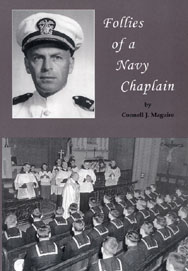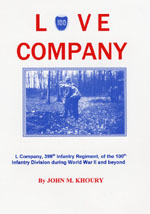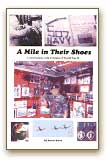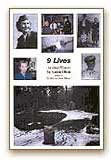©2014 John M. Khoury
Chapter 9
The First Battle
On 1 November 1944, in the fastest deployment in U.S. military history of an entire infantry division, the 3rd platoon of Love Company was the first rifle unit to move into the front line to relieve troops of the 45th Infantry Division. We were the last for roll call, last in a parade, last to board the ship, but first to disembark and first to enter combat.
We dug foxholes that had three men in each one. As night fell, we could see flashes in the sky followed by the boom of cannon fire. It was an eerie feeling being in a hole in the ground with two other soldiers peering into the blackness, tensely listening to all the eerie and strange sounds that come in the night. Was it some enemy movement? It could be an enemy patrol. There might be an assault on our front or maybe an attack from the flank. No green soldier at the front sleeps soundly that first night.
Al Lapa remembers being assigned to an old French Army dugout from World War I with John Bolin and Angelo Argiris where there was about two inches of water covering half of the bottom. It rained all night and the log roof leaked, and none of them got much sleep. Toward morning, Bolin and Lapa thought they heard noises in front of their position and challenged, "Who goes there?" When they received no reply, Bolin fired his BAR (Browning Automatic Rifle) and Lapa joined in with his M1 rifle. Then the whole platoon started firing, but there was no return fire. Daylight revealed just shredded branches. I suspect that some rabbit or other animal made the noises that brought on the fusillade. We soon learned to attune our hearing to most of the weird sounds that are part of the forest world at night.
On 3 November 1944 we moved up to relieve a rifle company of the 45th Infantry Division that was surrounded and pinned down by the Germans. As we were passing through, some of the soldiers of the 45th smirked and thought that we were very green. That was true. We did not know anything at all about what lay ahead. We carried full field packs that contained much equipment that we later learned we did not need. Nevertheless, they were happy to see us and to get much needed relief.
Ahead of us were the wooded slopes of the lower Vosges Mountains that the enemy was defending stubbornly. As we advanced, we were immediately subjected to intense small arms fire from the enemy. They were dug into camouflaged defensive positions and were firing machine guns that spewed bullets at twice the rate of ours. These "burp" guns fired l,600 rounds per minute against our 900 rounds per minute. They also had rapid-fire machine pistols that were called "Schmiessers," bolt-action Mauser rifles, and concussion hand grenades shaped like oversized eggs that they threw at us. We fired back with our semi-automatic Garand M1 rifles and BAR automatic rifles. We had some support from our 30 caliber light and heavy machine guns, which are not mobile weapons. They cannot be used in a close infantry attack with their tripod mounts, ammunition belts, and extra barrels to replace burned-out ones. They each require a gunner and an ammunition bearer to operate, which makes them most useful for defense against an enemy attack or for cover during an infantry advance.
Meanwhile, the noise was deafening all around us. I lay behind a tree with my 1903 sniper's rifle trying to see something to aim at. Nearby I could hear an M1 rifle going full blast. Eight rounds were fired and the clip flew out of the chamber and another clip of eight was thrown
in and they were fired. At this point I yelled to Lapa, "Hey! Skull! What are you firing at?" He yelled back, "I don't know, but I am going to scare the hell out of them!"
Then I heard someone yell, "MEDIC! MEDIC! I'M HIT!" At that moment, I heard and felt the crack of a rifle bullet fly right by my head. Instinctively, I looked up into a tree directly in front of me about 50 yards away and saw a puff of smoke. Though I could not see anyone, I aimed my sniper's rifle at the spot and fired each of the five rounds in my rifle. Each time I fired, I had to pull back the bolt, eject the spent cartridge shell, and push the bolt forward to insert a new round into the chamber. My rifle gave me and my shoulder a powerful jolt each time I fired a round and the smoke from the muzzle kept me from seeing if I had hit anything.
Now I had to reload my bolt-action rifle. Because of the telescopic sight mounted over the breech opening, I could not feed the clip of five rounds at one time. I had to take each round off the clip and load one at a time. As I was doing this, the firing all around me kept up at a furious pace. Suddenly, I heard a voice almost in a whisper say, "Nicht schiessen!" I looked to my right, and there was a German soldier no more than six feet away, staring me in the face! "Nicht schiessen? Don't shoot?" My rifle was not even loaded! He could have easily shot me or bayoneted me before I could have defended myself!
Somehow, I was more surprised than frightened as I stared at him. I pointed my rifle for him to move down the hill behind me. I held my rifle on him and crawled back down the hill after him. I escorted him a short distance to the rear. He was frightened and trembled as he walked in front of me with his hands on his head. When I searched him, he became agitated because he thought I wanted to take the bread he had in his pocket! It turned out that he had no weapon, grenade or ammunition.
As he was marching off into the 45th Division area, one of their men said to me, "Let's see how big a hole you can put in his back." That struck me as insane, because I could have been dead just a few minutes before. Besides, if we shot every enemy soldier who wanted to surrender, none ever would. The result would be a total disaster with more dead soldiers on both sides. The stories of the killing of prisoners of war on the Russian Front were heard on our front. Nevertheless, the war was over for that German, but not for me. From that moment on, I knew I had received a gift of time that I prayed would last until the end of the war.
I rejoined my platoon and continued the fire fight. The Germans were routed, and we pushed through to new positions beyond the woods. Later, 1st Lt. Park Ashbrook, our company executive officer, told me I had hit the sniper in the tree. When I said that I hadn't seen anything when I was firing, he said he saw him fall to the ground. Then it came to me that the sniper fire had stopped after I had shot those five rounds into the tree. (Frank Hancock of Company M, which is a heavy machine gun and mortar company, recalls that he had followed us on this attack and found a dead German soldier who had been killed by a bullet wound in his chest. (Perhaps, he had been the enemy sniper.)
In this baptism of fire, the men of Love Company had faced the enemy in relief of a veteran 45th Infantry Division unit and proved themselves ready and able.
The Morning Reports of 3 and 4 November 1944: 1 SWA and 2 LWA. Also 1 NBC GSW self inflicted. (SWA -- Severely wounded in action; LWA -- Lightly wounded in action; NBC -- Not battle connected; GSW -- Gun shot wound).
(If you would like to order an autographed copy of "Love Company," please contact the author, John M. Khoury)







